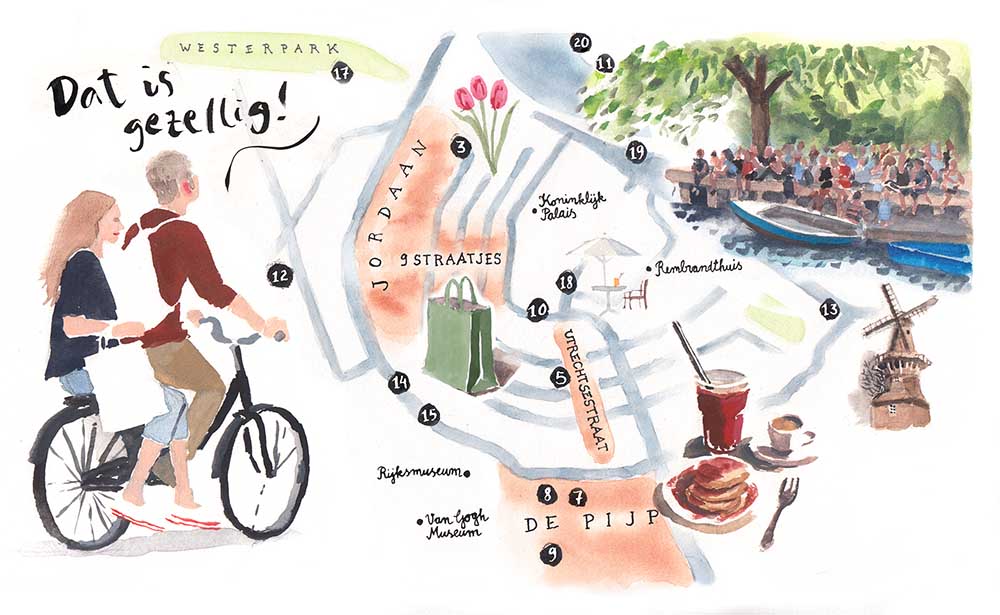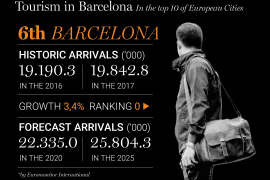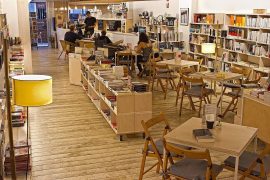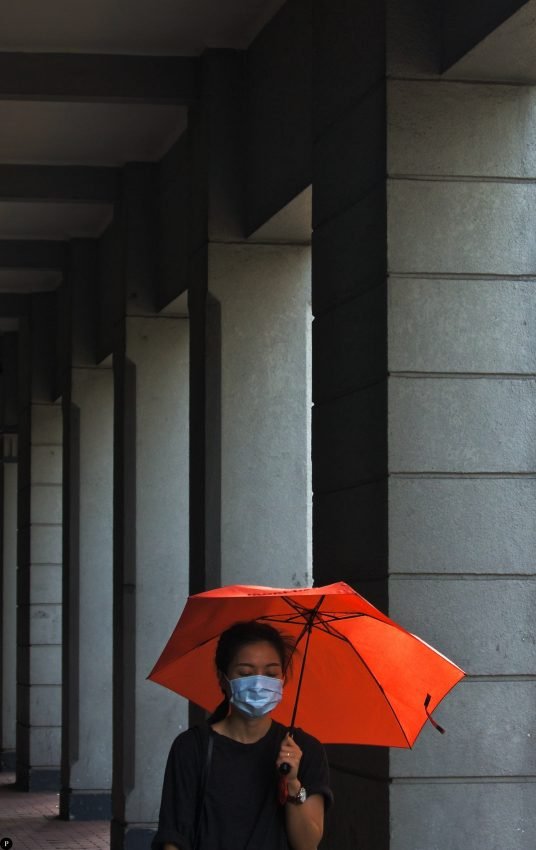[dropcap letter=”W”]
andering around the Jordaan neighborhood (1) and the western part of the canal ring, it seems impossible to be in the very centre of a large European capital. With a soundtrack of bicycle and bells and a set of houses looking at each other in the water surface, nobody would say that, less than a kilometre far from it, masses of tourists wander through the Red-Light District while trams, cars and pedestrians are frantically interpolated at Dam Square. Here, the rhythm is calm: the amsterdammers buy at designer shops of the 9 straatjes (9 streets) (2) and, with their prizes already in the bag, sit down to sip tea, coffee or drink beer in one of the small corner terraces. On Saturdays and Monday mornings, life is concentrated at Noordermarkt (3): a street market where you can buy from organic vegetables to a vintage coat, that seems taken from a spy movie.
Further on, direction South, on Utrechtsestraat Street (4) music treasure-hunters spend hours at Concerto (5), a five-floors historical record store where time flies, while rummaging boxes of new and discontinued CD cases and vinyl records.
For everything else, Amsterdam’s place-to-be is the De Pijp neighborhood (6). There, mornings are made to wander around the Albert Cuyp Markt (7), with plenty of flower stands, cheese, fresh food and odds and ends to buy. The gourmand ones go for bags of stroopwafels – artisan cookies filled with caramel- and, around noon, the lines begin to form around the fish stalls. Everyone wants to eat haring -raw herring served with onions and pickles in hot dog bread- or kibbeling -slices of battered and fried fish- and be able to continue walking. Snoop around in decoration shops at Gerard Doustraat Street (8) or have coffee in fashionable places like Coffee & Coconuts (9) are always good afternoon plans.
UNKNOWN PLACES FOR ORDINARY LIFE
 There are cinemas in Amsterdam where the simple act of going inside is already a cinematic experience. The Tuschinski (10) is the most extraordinary of them all: a crazy art-deco work, built in 1921, where cinema is not only seen, it is breathed. The impressive lobby with tapestries and frescoes covering the walls is only an aperitif of the sensuous pleasure that comes when sitting in its stalls. In addition, every spring, its screen speaks Spanish during the Amsterdam Spanish Film Festival. The EYE (11) is another option related to cinema: home of the film library and the national film archives, this museum-room emerges over the waters of the IJ River with its impressing, white and dynamic architectural profile, and makes the retinas of moviegoers and contemporary architecture lovers enjoy equally.
There are cinemas in Amsterdam where the simple act of going inside is already a cinematic experience. The Tuschinski (10) is the most extraordinary of them all: a crazy art-deco work, built in 1921, where cinema is not only seen, it is breathed. The impressive lobby with tapestries and frescoes covering the walls is only an aperitif of the sensuous pleasure that comes when sitting in its stalls. In addition, every spring, its screen speaks Spanish during the Amsterdam Spanish Film Festival. The EYE (11) is another option related to cinema: home of the film library and the national film archives, this museum-room emerges over the waters of the IJ River with its impressing, white and dynamic architectural profile, and makes the retinas of moviegoers and contemporary architecture lovers enjoy equally.
In Amsterdam, the old tram depot is today the largest food market, Foodhallen (12), with more than 20 street-food, wine and beer stands. The old De Gooyer mill also changed its job and stopped producing flour to become home of the Brouwerij’t IJ (13) craft brewery, a classic Amsterdammer. At night, it is easy to finish at the Melkweg (14), an old milk factory converted into a cultural place where, in addition, you can go out and party until dawn. Another night icon is Paradiso (15): a concert hall that was first a church and that, in its 40 years of history, staged concerts of names such as David Bowie, The Rolling Stones or Nirvana.
Sunday mornings are to go to the park, and the favourite destination is always Westerpark (16). This formerly polluted land that was a gas factory for almost 100 years is today the preferred green space to walk or play sports without having to dodge tourists. In one of its old factory buildings is the emblematic Pacific Parc (17), a cozy place where you can either eat breakfast or dance (since it opens uninterruptedly from 11 in the morning to 4 in the morning). Here, the abandoned factories always have a lot to offer.
GEZELLIGHEID NEXT TO THE WATER
In Holland, nice situations are gezellig. The Dutch are essentially enjoyers and, in Amsterdam, the gezelligheid (the feeling of being at ease) can often be experienced -especially when the weather is fine- next to the water. After all, the city has the soul of a port: water flows through its streets with the same naturalness as bicycles. Although any shore is good for sitting and rocking your legs over a canal, there are places where the pleasure of its presence increases. From the terrace of Café de Jaren (18) for example, one can see that boats glide peacefully on the Amstel, they appear and disappear behind the coffee cup. Further North, very close to the central train station, the canals draw the profile of the large terrace of the Hannekes Boom (19) and amplify the euphoria of its visitors on sunny days.
But it is the Pllek (20) the place that combines water and gezelligheid in the best way. Looking across the city from the other side of the IJ River, the Pllek is a castle of ship containers converted into a bar-restaurant. To get there you have to get on the ferry, cross the river zigzagging between cargo ships and surround the old abandoned shipyards. On a sunny day, its fine sand terrace is an anthill of life and, when it rains, its huge windows filter the leaden light creating an atmosphere like a nineties video clip. Nobody said that a grey sky had to be at odds with gezelligheid, especially not in Amsterdam.
Shopping areas for strollers
1. Jordan neighborhood and “the 9 streets”
2. 9 Straatjes
3. Noordermarkt
4. Utrechtsestraat
5. Concerto
6. Pipj neighborhood
7. Albert Cuyp Markt
8. Gerard Doustraat
9. Coffee & Coconuts
Unusual places for ordinary life
Cinemas
10. Tuschinski
11. EYE
Eat and drink
12. Foodhallen
13. Brouwerij’t IJ
Go partying
14. Melkweg
15. Paradiso
Park
16. Westerpark
17. Pacific Parc
Enjoying over the water
18. Cafè de Jaren
19. Hannekes Boom
20. Pllek




















